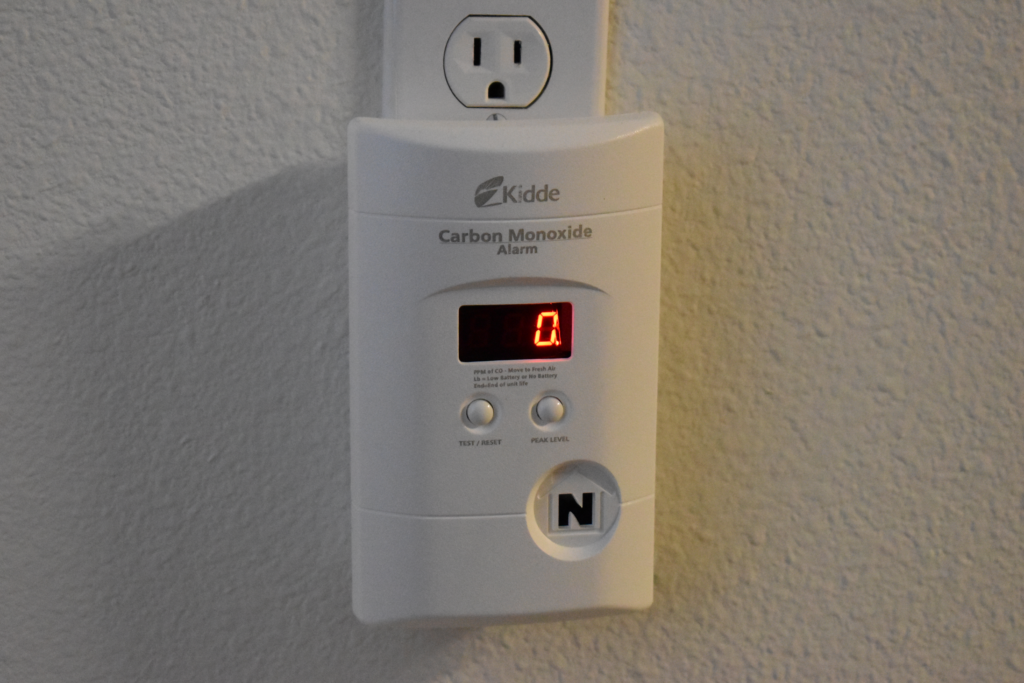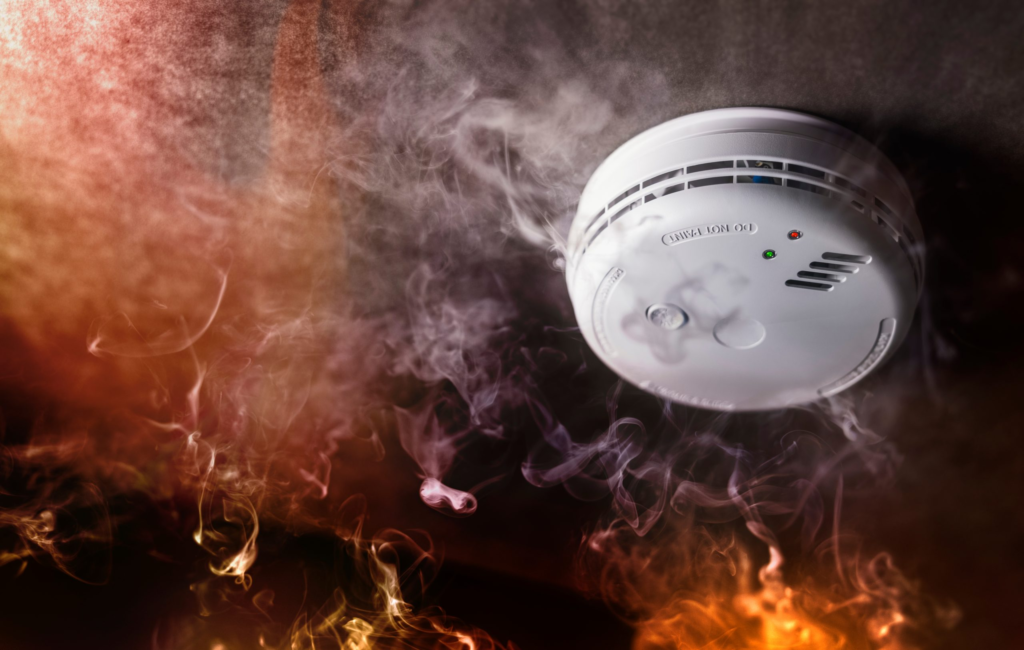Carbon monoxide (CO) is often called the “silent killer” for good reason. This odorless, colorless gas can build up in homes without any obvious signs, potentially leading to severe health issues or even death. Despite its dangers, many households still lack proper protection against this insidious threat. This blog post will explore why carbon monoxide detectors are crucial for safeguarding your home and loved ones.

We’ll delve into how these devices work, where they should be installed, and the peace of mind they can provide. By the end, you’ll understand why investing in carbon monoxide detectors is not just a smart decision, but a potentially life-saving one.
What is Carbon Monoxide and Why is it Dangerous?

Carbon monoxide (CO) is a gas that you can’t see, smell, or taste. This is why it’s often called the “silent killer.” But what exactly is this gas, and why should we be concerned about it?
Let’s start with the basics. Carbon monoxide is created when fuels like gas, oil, coal, or wood don’t burn completely. This can happen in many household appliances if they’re not working correctly or are used improperly. Some common sources of carbon monoxide in homes include:
- Furnaces and boilers
- Gas stoves and ovens
- Fireplaces and wood stoves
- Car engines running in attached garages
- Portable generators
Now, why is carbon monoxide so dangerous? The main reason is how it affects our bodies. When we breathe in carbon monoxide, it enters our bloodstream and prevents oxygen from reaching our organs and tissues. This can lead to carbon monoxide poisoning, which can be very serious and even fatal.
The symptoms of carbon monoxide poisoning can be tricky to spot because they often resemble other illnesses. Some common signs include:
- Headache
- Dizziness
- Weakness
- Nausea
- Confusion
- Chest pain
- Vomiting
In severe cases, carbon monoxide poisoning can cause loss of consciousness and death. What makes it even more dangerous is that people who are sleeping or drunk may not notice the symptoms before it’s too late.
The risks of carbon monoxide are especially high in enclosed spaces where the gas can build up quickly. This is why it’s crucial to have proper ventilation in your home and to never use outdoor appliances (like grills or generators) indoors.
Carbon monoxide safety is not something to take lightly. The good news is that there are steps you can take to protect yourself and your family. The most important one is installing carbon monoxide detectors in your home. These devices can alert you to dangerous levels of CO before they become life-threatening.
In addition to detectors, regular maintenance of your fuel-burning appliances is key. Have a professional check your heating system, water heater, and any other gas, oil, or coal-burning appliances every year. Also, never leave your car running in an attached garage, even with the door open.
Remember, you can’t rely on your senses to detect carbon monoxide. That’s why it’s called the silent killer. But with the right precautions and awareness, you can keep your home safe from this invisible threat.
By understanding what carbon monoxide is and why it’s dangerous, you’ve taken the first step in protecting yourself and your loved ones. In the next sections, we’ll discuss more about carbon monoxide detectors and other safety measures you can take.
Also Read: Illuminating Safety: The Importance of Fire Safety LED Exit Signs and Boards
Understanding the Different Types of Carbon Monoxide Detectors

Carbon monoxide detectors are crucial safety devices for your home. But did you know there are several types available? Let’s explore the different options to help you choose the best one for your needs.
1. Basic Carbon Monoxide Alarms
These are the simplest and most common type of carbon monoxide detectors. They work by sounding an alarm when they detect dangerous levels of CO in the air. Basic alarms are affordable and easy to install. They usually run on batteries, which means they’ll work even during power outages. However, you’ll need to remember to change the batteries regularly.
2. Digital Display Carbon Monoxide Detectors
These detectors have a screen that shows the current CO levels in your home. This feature can be helpful because it allows you to see if CO levels are rising, even if they haven’t reached dangerous levels yet. Some digital models also show the peak CO level detected over time, which can be useful information for safety inspectors or repair technicians.
3. Smart Carbon Monoxide Detectors
These high-tech devices can connect to your home’s Wi-Fi network. They can send alerts to your smartphone if they detect CO, even when you’re not at home. Some smart detectors can also be integrated with other smart home devices, like thermostats or security systems.
4. Combination Smoke and Carbon Monoxide Detectors
Also known as combo detectors, these devices can detect both smoke and carbon monoxide. They’re a popular choice because they combine two essential safety features in one unit, saving space and potentially money. However, it’s important to note that smoke and CO detectors often work best when placed in different locations, so combo units might not always be the ideal solution for every room.
5. Plug-in Carbon Monoxide Detectors
These detectors plug directly into your wall outlets. They’re easy to install and don’t require battery changes. Many plug-in models also have battery backups, so they’ll keep working during power outages. The downside is that their placement is limited to areas with available outlets.
6. Hardwired Carbon Monoxide Detectors
These are permanently wired into your home’s electrical system. They’re often required in new construction. Hardwired detectors usually have battery backups for added safety. While they provide consistent power, they typically need professional installation.
7. Biomimetic Sensor Detectors
These use a gel that changes color when it absorbs carbon monoxide. This color change triggers the alarm. They’re known for having fewer false alarms but may be slower to detect sudden CO spikes.
8. Metal Oxide Semiconductor Detectors
These use a silica chip to detect CO. When carbon monoxide is present, it lowers the electrical resistance in the chip, triggering the alarm. They’re sensitive and affordable but use more power than other types.
9. Electrochemical Sensor Detectors
These are considered the most accurate type of CO detector. They use a chemical reaction to detect carbon monoxide. When CO is present, it creates a small electrical current that sets off the alarm. They’re highly sensitive and have a long lifespan, but they’re often more expensive than other types.
When choosing a carbon monoxide detector, consider factors like your home’s layout, your budget, and any specific needs you might have (like smart home integration). Remember, the most important thing is to have working CO detectors installed on every level of your home and near sleeping areas.
No matter which type you choose, make sure to test your detectors regularly and replace them according to the manufacturer’s instructions. Most CO detectors need to be replaced every 5-7 years.
By understanding the different types of carbon monoxide detectors available, you can make an informed decision to best protect your home and family from this silent threat.
Also Read: Fire Extinguishers: Your First Line of Defense Against Fires
How to Choose the Right Carbon Monoxide Detector for Your Home

Selecting the best carbon monoxide detector for your home is a crucial decision that can potentially save lives. Here’s a guide to help you make the right choice:
1. Consider Your Home’s Layout
The size and layout of your home will influence how many detectors you need and where to place them. As a general rule:
– Install at least one CO detector on each level of your home
– Place detectors near sleeping areas
– Consider additional detectors near potential CO sources (like the kitchen or garage)
2. Understand CO Detector Placement
Proper placement is key to effective carbon monoxide detection:
– For wall-mounted units, place them at least 5 feet above the floor
– For ceiling-mounted units, keep them at least 6 inches from the wall
– Avoid placing detectors near windows, doors, or vents
– Don’t install them in very humid areas like bathrooms
3. Know Your Local Carbon Monoxide Alarm Requirements
Carbon monoxide detector requirements can vary by location. Check your local laws to ensure compliance. Some common requirements include:
– Mandatory CO detectors in all residential buildings
– Specific placement rules (e.g., one on each floor, near bedrooms)
– Regular testing and replacement schedules
4. Choose the Right Type of Detector
Consider the various types we discussed earlier:
– Basic alarms are affordable and reliable
– Digital display models show current CO levels
– Smart detectors can send alerts to your phone
– Combination smoke and CO detectors save space
5. Look for Important Features
When selecting the best carbon monoxide detector, consider these features:
– UL certification (look for UL 2034 standard)
– Digital display for current CO levels
– Peak level memory to record highest CO concentration
– End-of-life warning to remind you when to replace the unit
– Battery backup for hardwired models
6. Consider Smart Carbon Monoxide Detectors
If you’re tech-savvy or often away from home, a smart CO detector might be a good choice. Benefits include:
– Remote alerts on your smartphone
– Integration with other smart home devices
– Regular self-testing and status updates
7. Check the Sensor Type
Different sensors have different strengths:
– Electrochemical sensors are highly accurate and sensitive
– Metal oxide semiconductor sensors are affordable but use more power
– Biomimetic sensors have fewer false alarms but may be slower to detect sudden CO spikes
8. Consider Power Source
Choose between:
– Battery-powered: Work during power outages but require regular battery changes
– Plug-in: Easy to install but limited by outlet locations
– Hardwired: Consistent power but may need professional installation
9. Look at Lifespan and Warranty
Most CO detectors last 5-7 years. Check the manufacturer’s stated lifespan and warranty. Some offer up to 10-year warranties.
10. Read Reviews and Compare Prices
Look at customer reviews to see real-world performance. Compare prices, but remember that the cheapest option isn’t always the best when it comes to safety devices.
11. Consider Special Needs
If you have hearing impairments, look for detectors with visual alarms or vibration features.
Remember, the best carbon monoxide detector is one that’s properly installed, regularly tested, and correctly placed in your home. No matter which model you choose, make sure to follow the manufacturer’s instructions for installation, testing, and maintenance.
By considering these factors, you can choose a carbon monoxide detector that provides reliable protection for your home and family against this invisible threat.
Also Read: Understanding Fire Annunciators: A Comprehensive Guide
Integrating Carbon Monoxide Detectors with Your Home’s Fire Alarm System

Combining carbon monoxide detection with your existing fire alarm system can provide comprehensive protection for your home. Let’s explore how to do this effectively:
1. Fire and Carbon Monoxide Detector Combos
These devices are designed to detect both smoke and carbon monoxide, offering dual protection in a single unit. Benefits include:
– Space-saving: One device does the job of two
– Cost-effective: Often cheaper than buying separate units
– Simplified maintenance: You only need to check and replace one device
However, keep in mind that ideal placement for smoke detectors might differ from CO detectors, so carefully consider positioning.
2. Interconnected Alarms
Interconnected alarms communicate with each other, so when one detects a threat, all alarms in the house sound. This feature is particularly useful for larger homes. Here’s what you need to know:
– Wired interconnection: Alarms are physically connected through your home’s wiring
– Wireless interconnection: Alarms communicate via radio frequency signals
– Mixed systems: Some modern systems allow both wired and wireless interconnection
Advantages of interconnected alarms:
– Faster alert: You’ll be warned no matter where you are in the house
– Improved safety: Especially beneficial for multi-story homes or houses with sleeping areas far from potential CO sources
3. Smart Home Carbon Monoxide Detectors
These high-tech devices can be integrated into your smart home system, offering advanced features:
– Smartphone alerts: Get notifications on your phone even when you’re away from home
– Voice alerts: Some models can tell you which room has detected CO
– Integration with other smart devices: Can trigger actions like turning on lights or HVAC system when CO is detected
– Remote testing and monitoring: Check your detector’s status from anywhere
4. Carbon Monoxide and Smoke Alarm Combo in Smart Systems
Many smart home security systems now offer combination smoke and CO detectors that can be fully integrated with other smart home features:
– Central monitoring: Some systems offer professional monitoring services
– Automated responses: Can be set to automatically shut off HVAC systems or activate ventilation when CO is detected
– Historical data: Track CO levels over time for better understanding of your home’s air quality
5. Installation Considerations
When integrating CO detectors with your fire alarm system:
– Follow manufacturer guidelines for placement
– Ensure all devices are compatible if mixing brands
– Consider professional installation for hardwired or complex systems
– Check local building codes for any specific requirements
6. Maintenance and Testing
Integrated systems require regular maintenance:
– Test all alarms monthly
– Replace batteries as needed (for battery-powered units)
– Replace entire units according to manufacturer recommendations (typically every 5-10 years)
– Keep all sensors clean and free from dust
7. Backup Power
Ensure your integrated system has backup power:
– Battery backup for hardwired systems
– Uninterruptible power supply (UPS) for smart home hubs
8. Training Family Members
Make sure everyone in the household understands:
– What the different alarm sounds mean
– How to respond to CO and fire alarms
– How to silence false alarms
– The importance of not disabling detectors
9. Future-Proofing Your System
Consider:
– Scalability: Choose a system that allows for easy addition of more detectors
– Updates: Smart systems often receive software updates to improve functionality
– Compatibility: Ensure your system can work with other smart home devices you might add in the future
Integrating carbon monoxide detectors with your home’s fire alarm system provides comprehensive protection against two significant household dangers. Whether you opt for simple combo detectors or a fully integrated smart home system, the key is to ensure full coverage of your living space and to maintain your system properly.
Remember, while integration offers many benefits, the most important factor is having working CO and smoke detectors in the right locations throughout your home.
Certainly. I’ll provide detailed information on installing and maintaining carbon monoxide detectors, focusing on the key points you’ve outlined.
Also Read: Understanding Fire Protection System: Types, Components, and Maintenance
Installing and Maintaining Your Carbon Monoxide Detectors

Proper installation and regular maintenance of your carbon monoxide detectors are crucial for ensuring they function effectively when you need them most. Let’s break this down into key areas:
1. How to Install Carbon Monoxide Detectors
Correct installation is vital for optimal performance:
a) Placement:
– Install at least one detector on every level of your home
– Place detectors near sleeping areas
– Install detectors at least 15 feet away from fuel-burning appliances
– For wall-mounted units, place them at least 5 feet above the floor
– For ceiling-mounted units, keep them at least 6 inches from the wall
b) Installation steps:
1. Choose your location based on the guidelines above
2. Mark the drill holes using the mounting bracket as a template
3. Drill holes and insert wall anchors if needed
4. Screw the mounting bracket to the wall or ceiling
5. Attach the detector to the mounting bracket
6. For hardwired models, connect the wires according to the manufacturer’s instructions
7. Install batteries if required
8. Test the detector to ensure it’s working properly
2. Carbon Monoxide Detector Battery
Many CO detectors are battery-powered or have battery backups. Here’s what you need to know:
– Types of batteries: Most use AA, AAA, or 9-volt batteries. Some newer models use sealed lithium batteries that last for the detector’s entire lifespan
– Replacement schedule: For units with replaceable batteries, change them at least once a year. A good rule of thumb is to do this when you change your clocks for daylight saving time
– Low battery warning: Most detectors will chirp or give some other signal when the battery is low. Don’t ignore this warning
– Battery check: Test batteries monthly along with your detector test
3. Carbon Monoxide Detector Lifespan
CO detectors don’t last forever. Understanding their lifespan is important:
– Average lifespan: Most CO detectors last 5-7 years
– End-of-life warning: Many modern detectors will signal when they’ve reached the end of their useful life
– Replacement: Mark the purchase date on your detector and replace it according to the manufacturer’s recommendations, even if it seems to be working fine
– Disposal: Check local regulations for proper disposal of old detectors, as some may be considered electronic waste
4. Testing Carbon Monoxide Detectors
Regular testing ensures your detectors are functioning correctly:
a) How to test:
1. Locate the “Test” button on your detector
2. Press and hold the button for a few seconds
3. Wait for the alarm to sound (it might take up to 20 seconds)
4. If the alarm doesn’t sound, check the power source and try again
5. If it still doesn’t work, replace the detector immediately
b) Testing schedule:
– Test all CO detectors at least once a month
– Some manufacturers recommend weekly testing
c) Additional testing tips:
– Use the test button only. Never use actual CO to test your detector
– After testing, make sure everyone in the household knows the sound of the alarm
– Some smart detectors allow you to test them remotely via a smartphone app
5. General Maintenance Tips
Beyond battery replacement and regular testing, keep these maintenance tips in mind:
– Cleaning: Gently vacuum your detector monthly to remove dust and debris
– Avoid paint: Never paint over a CO detector
– Check for recalls: Periodically check if your model has been recalled
– Keep manual safe: Store the user manual in a known location for future reference
– Update emergency contacts: If your detector is connected to a monitoring service, keep your emergency contact information up to date
6. Signs Your Detector Needs Replacement
Replace your CO detector if:
– It fails a test even with new batteries
– It starts making intermittent chirping or beeping sounds that don’t stop after replacing the batteries
– It’s visibly damaged or has been painted over
– It’s past its expiration date
Remember, proper installation and diligent maintenance of your carbon monoxide detectors are key to keeping your home and family safe. These devices are your first line of defense against the silent threat of carbon monoxide, so it’s crucial to keep them in good working order.
Also Read: The Essential Guide to Understand types of Fire Extinguishers, Uses, Maintenance
Conclusion: Don’t Gamble with Your Family’s Safety – Invest in Carbon Monoxide Detectors Today
Throughout this article, we’ve explored the critical role that carbon monoxide detectors play in protecting your home and loved ones. Let’s recap the key points and underscore why immediate action is crucial:
- Silent Danger: Carbon monoxide is odorless, colorless, and potentially lethal. Without proper detection, you and your family could be at risk without even knowing it.
- Widespread Threat: CO can come from many common household sources, including furnaces, water heaters, and even your car in an attached garage.
- Effective Protection: Modern CO detectors are reliable, affordable, and could literally save your life.
- Various Options: From basic alarms to smart, interconnected systems, there’s a CO detection solution for every home and budget.
- Easy Implementation: Installing and maintaining CO detectors is straightforward, requiring minimal effort for maximum peace of mind.
The stark reality is that carbon monoxide poisoning can happen to anyone, anywhere. It doesn’t discriminate based on location, home type, or family size. Every year, thousands of people suffer from CO poisoning, with many cases resulting in fatalities that could have been prevented with proper detection.
By investing in carbon monoxide detectors, you’re not just buying a device – you’re investing in your family’s safety and your own peace of mind. The cost and effort of installing these life-saving devices pale in comparison to the potential consequences of not having them.
Remember, you can’t see, smell, or taste carbon monoxide. Your senses alone cannot protect you from this silent threat. Only a properly functioning CO detector can provide the early warning you need to keep your family safe.
Don’t wait for a close call or a tragedy to take action. Every moment without CO detection is a gamble with your family’s well-being. Make the decision today to protect your home with carbon monoxide detectors.
Install them correctly, maintain them regularly, and rest easier knowing you’ve taken a crucial step in safeguarding your loved ones against this invisible danger. Your family’s safety is priceless – invest in it today with carbon monoxide detectors.








1 thought on “The Importance of Carbon Monoxide Detectors 101: Protecting Your Home and Family”
Pingback: Exploring the Different Types of Fire Hydrant Valves
Comments are closed.